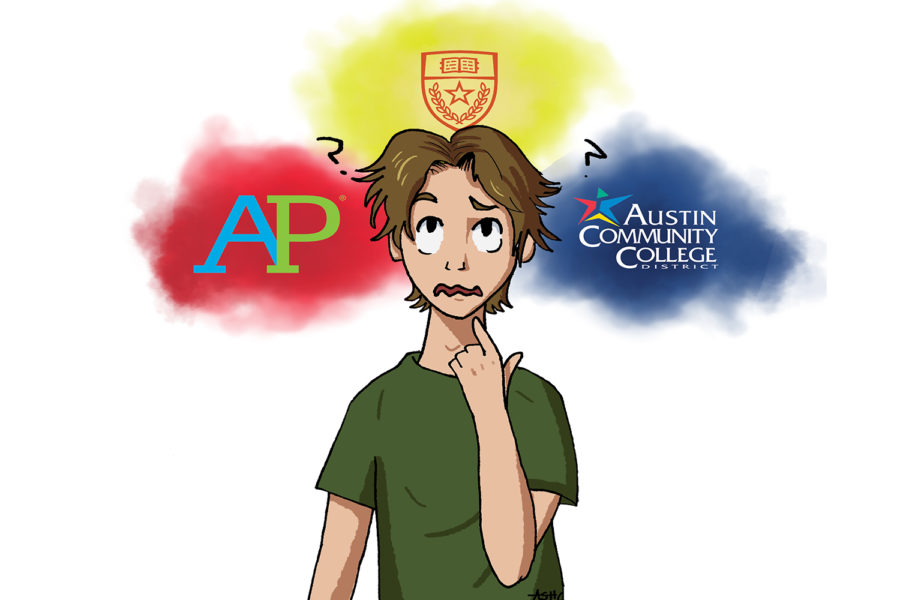Students need to do research on all advanced courses
Advanced academic classes give students who are motivated a chance to earn college credit. They are also a safe way for students who are unsure if they are ready for college to try out college-level work.
February 22, 2019
AP classes have been considered a national standard for advanced academics offerings for high school.
However, the face of advanced academics is changing to reflect a new need for other kinds of options. This is where The University of Texas (UT)’s OnRamps dual enrollment program and Austin Community College (ACC)’s dual credit program come into play. Akins offers all three options, giving students multiple ways to earn college credit and get a taste of what college can be like.
AP classes and tests have long been considered the gold standard when it comes to advanced academics. The class is designed by the AP teacher as well as all unit tests, supplementary work, and other assignments except for the final AP exam which is coordinated by College Board, the organization that offers the SAT (Scholastic Aptitude Test), PSAT (Preliminary Scholastic Aptitude Test) as well as AP and Pre-AP classes. However, in the 2019/2020 school year, this will be changing.
“AP is making some changes next year and one of the changes they’re doing, and I think it’s really good for equity across the country, is that they are providing all AP teachers with (curriculum) material,” AP Coordinator and English teacher Rebecca Redland-Sturzl said. “(College Board is providing) modules so that if a teacher sees that a student or a class needs to work on a concept then they can have them go online to that module, similar to Khan Academy.”
To teach an AP class, a teacher must go through rigorous training for a couple weeks where they revisit material, teaching strategies, and meet with other AP teachers to assess what has worked and what hasn’t.
The teacher then has to design a syllabus and plan their class with supplementary work and other assignments to prepare their students for the AP exam. Every couple of years, the teacher has to resubmit their syllabus and planned work to the College Board for assessment.
OnRamps classes are a little different in that the assignments and tests are designed by a professor at the University of Texas and facilitated by a high school teacher at Akins. Students receive two grades: a college grade and a high school grade. The high school grade usually includes minor daily assignments while the college grade is tests, quizzes, and other major grades. Teachers also have to be trained for OnRamps courses and some teachers meet multiple times a year with the professor that organizes the class.
“The goal of the UT OnRamps dual enrollment program is to provide students who might not have taken an advanced academic course in the past, with the opportunity to experience a college class, with its rigorous work, expectations, and deadlines, with little risk,” said Christine Kesling, college readiness counselor and OnRamps coordinator.
Dual credit classes via Austin Community College (ACC) are just like taking a class at ACC as a college student. Some classes are offered at Akins while some have to be taken at an ACC campus. Others are offered via distance learning which means completely online. Students can also take these classes during the summer or in the evening on their own time. To take these classes, students must show college readiness by passing the Texas Success Initiative (TSI), SAT, or American College Testing (ACT) tests with satisfactory scores. This is not a requirement for AP or OnRamps classes. Students can take 12 courses for free but must pay for textbooks if needed.
The real issue students struggle with is comparing each type of advanced class. Some Akins students make blanket statements about OnRamps, AP or ACC being better than the other while chatting with their friends about their experiences. Students will often share personal stories about their experiences in these classes with their friends, but Kesling and Redland-Sturzl caution students against basing their decisions based solely on what their friends tell them. Instead, they recommend students research these options thoroughly before making a decision on what advanced academic class will be their best fit.
It’s critical that students know exactly what these classes offer and how they are structured. Students should also consider what is more important than them: earning college credit or a college-level experience. These should be the important factors if a student decides whether to take the leap into advanced academics. Advanced academics are designed to give high school students the opportunity to push themselves and dip their toes into college before paying thousands of dollars to take the same class.
In this way, these classes are almost a safety net for students who are motivated to earn college credit or for students who are unsure if they are ready for college or not. In my experience, advanced classes have given me the opportunity to find what kind of studying methods work for me specifically. This is very helpful to practice before paying a lot of money and time when students become a freshman in college.
My advice to future students who are considering advanced classes is to get as much information about each kind of class before signing up for it. It matters less about what other students have said and more about what kind of class will be better for your goals.
The real takeaway here is that all of these classes are offered to try to challenge motivated students and help them experience college before paying thousands of dollars. They’re not designed to make students fail, they’re designed to challenge students who are ready for a college experience.














